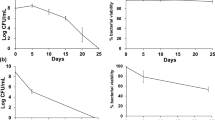Abstract
In general, proteome studies compare different states of metabolism to investigate external or internal influences on protein expression. In the context of mycotoxin production the method could open another view on this complex and could be helpful to gain knowledge about proteins which are involved in metabolism (enzymes, transporters). In this short technical report, we describe a new protocol suitable for protein preparation for whole proteome analysis ofFusarium graminearum. Cell lysis was performed by grinding the mycelium with liquid nitrogen. Proteins were extracted with TCA/acetone and then cleaned; the isolated proteins were separated in a 2D-gel electrophoresis system (BioRad) using different pH gradients. The protocol established seems also generally applicable for other mycotoxin producing fungi.
Similar content being viewed by others
References
Marin S, Sanchis V, Ramos AJ, Vinas I, Magan N (1998) Environmental factors,in vitro interactions, and niche overlap betweenFusarium moniliforme, F. proliferatum, andF. graminearum, Aspergillus andPenicillium species from maize grain. Mycol Res 102: 831–837
Hope R, Magan N (2003) two-dimensional environmental profiles of growth, deoxy-nivalenol and nivalenol production byFusarium culmorum on a wheat-based substrate. Lett Appl Microbiol 37: 70–74
Cooney JM, Lauren DR, Di Menna ME (2001) Impact of competitive fungi on trichothecene production byFusarium graminearum. J Agric Food Chem 49: 522–526
Prange A, Modrow H, Hormes J, Krämer J, Köhler P (2005) Influence of mycotoxin producing fungi(Fusarium, Aspergillus, Penicillium) on gluten proteins during suboptimal storage of wheat after harvest and competitive interactions between field and storage fungi. J Agric Food Chem 53: 6930–6938
Görg A, Weiss W, Dunn MJ (2004) Current two-dimensional electrophoresis technology for proteomics. Proteomics 4: 3665–3685
Phalip V, Delalande F, Carapito C, Goubet F, Hatsch D, Leize-Wagner E, Dupree P, VanDorsselaer A, Jeltsch J (2005) Diversity of the exoproteome ofFusarium graminearum grown on plant cell wall. Curr Genet 48: 366–379
Proctor RH, Hohn TM, McCormick SP (1995) Reduced virulence ofGibberella zeae caused by disruption of a trichothecene toxin biosynthetic gene. Mol Plant Microbe Interact 8: 593–601
Görg A (2003) Two-dimensional electrophoresis with immobilized pH gradients for proteome analysis: a laboratory manual.http:// www.weihenstephan.de/blm/deg
Görg A, Weiss W, Dunn MJ (2004) Current two-dimensional electrophoresis technology for proteomics. Proteomics 4: 3665–3685
Nandakumar MP, Marten MR (2002) Comparison of lysis methods and preparation protocols for one-and two-dimensional electrophoresis ofAspergillus oryzae intracellular proteins. Electrophoresis 23: 2216–2222
Grinyer J, McKay M, Nevalainen H, Herbert BR (2004) Fungal proteomics: initial mapping of biological control strainTrichoderma harzianum. Curr Genet 45: 163–169
Schlags W, Walther M, Masree M, Kratzel M, Noe CR, Lachmann B (2005) Towards validating a method for two-dimensional electrophoresis/silver staining. Electrophoresis 26: 2461–2469
O’Farrell PH (1975) High resolution two-dimensional electrophoresis of proteins. J Biol Chem 250: 4007–4021
Rabilloud T (1998) Use of thiourea to increase the solubility of membrane proteins in two-dimensional electrophoresis. Electrophoresis 19: 758–760
Chevallet M, Santoni V, Poinas A, Rouquie D, Fuchs A, Kieffer S, Rossignol M, Lunardi J, Garin J, Rabilloud T (1998) New zwitterionic detergents improve the analysis of membrane proteins by two-dimensional electrophoresis. Electrophoresis 19: 1901–1909
Author information
Authors and Affiliations
Corresponding author
Additional information
Financial support: Cusanuswerk (doctoral scholarship)
Rights and permissions
About this article
Cite this article
Milles, J., Krämer, J. & Prange, A. Development of a proteomic approach to monitor protein synthesis in mycotoxin producing moulds. Mycotox Res 23, 161–165 (2007). https://doi.org/10.1007/BF02946042
Received:
Accepted:
Issue Date:
DOI: https://doi.org/10.1007/BF02946042




